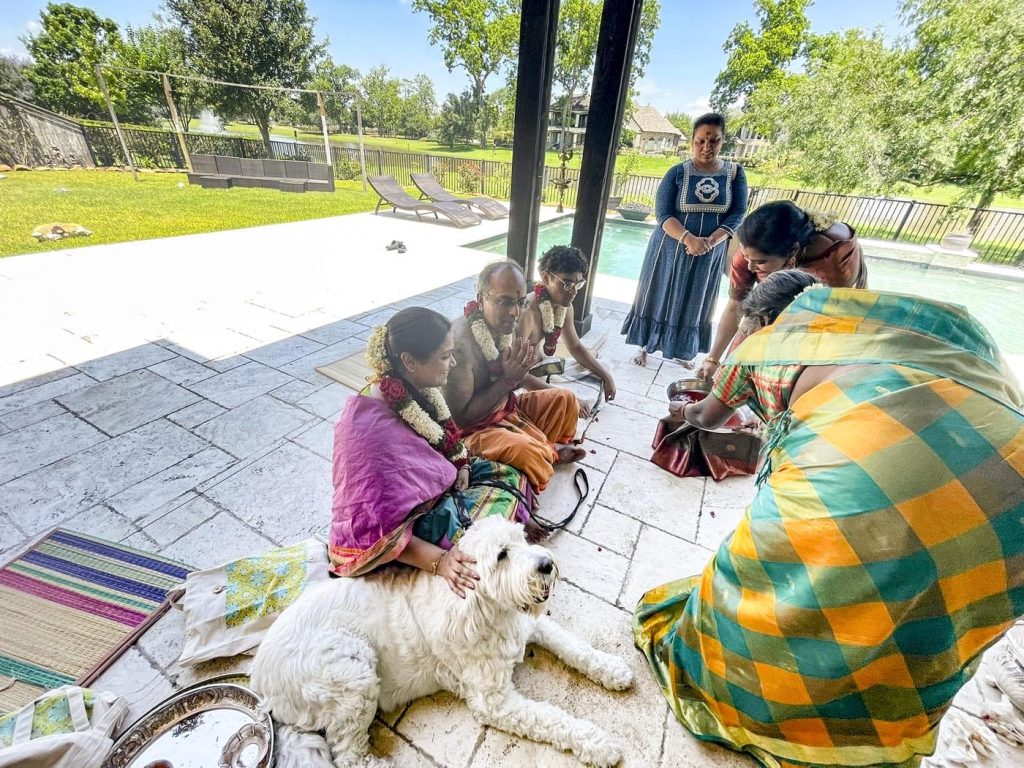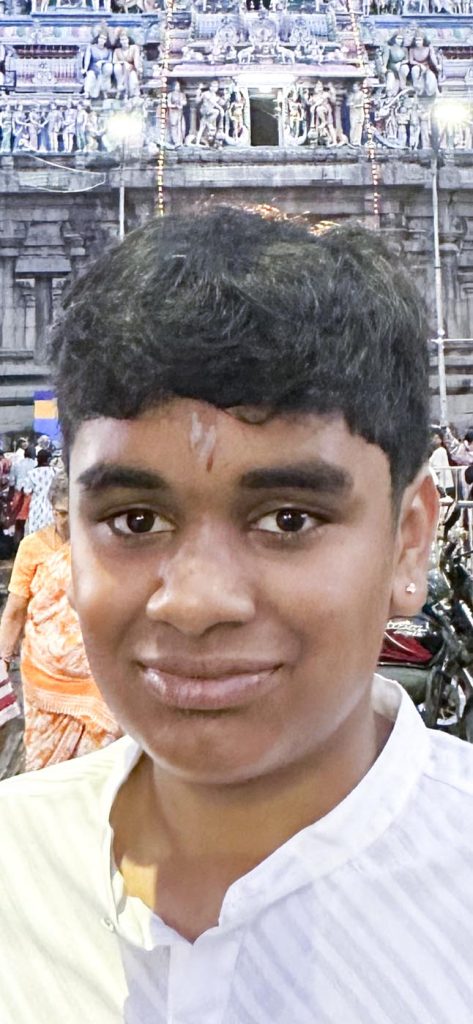Despite its length and complexity, the fire worship of the Goddess carries great significance for me personally
By Krathu Sankaranarayanan, Texas
all photos: courtesy krathu sankaranarayanan
A few weeks ago, on may 19, my familyperformed Chandi homa, which is believed to be the ultimate form of worship to Devi. The fire ceremony is complex and elaborate, and when done properly with the recitation of the 700 verses of Devi Mahatmyam for Goddess Chandika, it has the capacity to remove any hurdles in one’s life and bestow one with prosperity and spiritual upliftment. I am not an expert on it by any means, but I want to share my experiences and reflections as a devotee.
The Goddess in My Family’s Tradition
Devi worship has an important place on both sides of my family. On my mom’s side, Nachiyar Amman has been worshiped as the family Deity for generations. On my dad’s side, my great-great-great-grandfather built an Amman temple in Simizhi, Tamil Nadu. Because of this deep generational connection, we wanted to perform this elaborate homa at our house.
I am sure we all know the story where the Gods were fighting a demon called Mahishasura, who had been granted a boon that he could only be defeated by a woman. The Gods, therefore, caused three creative forces, Shaktis (or Devi), to unite and destroy him: Goddesses Maha Kali, Maha Lakshmi and Maha Saraswati. As this mighty unification of the three Goddesses, Chandika is referred to as Mahadevi, Vanquisher of Mahishasura. She is the subject of the Devi Mahatmyam, a part of the Markandeya Purana, and referred to by numerous other names, such as Chamundi, Katyayini and Mahishasuramardhini. Her vahana, or vehicle, is a lion, and she is visualized wearing a red sari.
Performing the Chandi homa requires highly trained priests who are expert in their craft and have years of experience. We were fortunate to have such priests in Houston who are devotees of Devi and have been performing large and complex rituals to Her.

The Ceremony as it Unfolded
The groundwork for the homa was fascinating—the priests start by building a brick enclosure called a homa kunda to house the sacred fire and in which to invoke Devi. A unique aspect of Her worship is that a circular fire altar is required, as opposed to a typical square.
We officially start by seeking permission from the Goddess for the worship, followed by the sankalpam—an oath to complete the homa and request for blessings—and a Ganapati puja. Ganapati is the remover of obstacles. We first seek His blessings, as without His grace, nothing can be done.
Next we perform a ceremony to purify and bless the kalasam, a brass pot filled with water and various other items. We invoke G0d Varuna in the kalasam and then recite the purifying Pavamana Suktam, found in the Yajur Veda. The water is then sprinkled around us.
There are three main kalasams, one for Maha Kali, one for Maha Lakshmi and one for Maha Saraswati. These are each connected to the homa kunda via a thin thread, which energizes them as we perform the fire worship. This thread takes the energies of the mantras and offerings and transmits them to the kalasams.
Next we formally invite the God of Fire, Agni, to enter the sacred flames in the homa kunda, a rite called Agni pratishthapanam. This is done because before the Agni pratishthapanam, the homa kunda houses just a simple fire, not Agni. We use dried coconuts, camphor and darba grass to invoke Him. In every homa, Agni Deva plays a critical role, as He is the vehicle of our offerings and prayers. Agni Deva has two heads and four horns and typically faces east. Since we are sitting at the western side of the homa kunda, we are also facing east, so we are looking at Agni’s back. We request Agni Deva to face us. We do this with the Sanskrit mantra meaning “Be faced toward me.” Then, we all begin the chanting of Devi Mahatmyam, which takes about three hours. During this homa, various dravya offerings such as sweet pongal, rice, flowers and turmeric are offered into the homa kunda. At the end of each sloka we say, “Svaha,” which means “salutations” or “hail” and is the name of one of Agni’s wives. Upon hearing “Svaha” Agni Deva opens his mouth and takes the offering to Devi.

As I listen to the chanting and explanations, I am thrilled to learn that many of the mantras and stories that I have heard and learned earlier come from the Devi Mahatmyam. Two famous slokas—“To that Devi, who dwells in all living creatures and is Shakti incarnate in all beings, I bow” and “O, personification of auspiciousness, o consort of Shiva, accomplisher of all, I bow to you”—both come from this wonderful collection of verses.
Before we start reciting each chapter, the priest takes time and explains its essence. Sitting through a long homa as a teenager can be difficult, but because of the storytelling aspect added by the priests, it almost felt like I was in an Amar Chitra Katha comic book myself, seeing all of this unfold before me. For many, a homa may seem like a recitation of a bunch of verses, but what is at its core is storytelling and invoking divine vibrations and energy. When you’re able to visualize the story and understand the spirit of it, the experience is at a whole different level, and you begin to appreciate it more.
Devi Mahatmyam, which means the “Greatness of Devi,” has 13 chapters, each dedicated to a different form of Devi as She defeats the demons. The first chapter is dedicated to Maha Kali and describes the demons Madhu and Kaitabha the dual energies of tamas and rajas, darkness and undirected energy. These two demons attempt to conquer the creative, sattvic force, also known as Brahma. Maha Kali destroys them with Her mightiness and protects the world from their demonical force.
After each chapter is chanted, a small offering of flowers and turmeric root is placed into the sacred fire to conclude the worship of that Devi. Chapters two, three and four narrate the battle between Devi and the demon Mahishasura. It begins with the Gods coming together in the mountains where they combined their shakti energies to form Chandika Devi. The newborn Goddess then leads a battle riding Her Lion and defeated Mahishasura.
Chapters five through thirteen, dedicated to Maha Saraswati, recount how She slays many demons, Dhumralochana, Chanda and Munda in particular. She then proceeds to battle and defeat Raktabhija, the demon who multiplies when a single drop of his blood touches the ground. In a sense Raktabhija reminds us how the mind multiplies negative thoughts, a process that should be curtailed by meditating on Devi. Finally, she battles Nishumba and Shumba and emerges victorious.
After reciting the entire Devi Mahatmyam, we performed an offering to Bhairava, a guardian form of Siva. A pumpkin was cut, and offered in different areas of the large homa kunda. Then the final offering, purnahuti, of coconut, flowers and fabric are offered into the sacred fire to end the homa.
I was very grateful that we had the fortune of being able to perform the Chandi homa at home. It was not an easy task and required lots of time commitment, materials and skilled priests to perform it.
What It Means to Me
All in all, performing Chandi homa was an eye-opening experience. I’ve always been emotionally connected with Devi, and She has been my Ishta Devam, or favorite Goddess, ever since I was a kid. Worshiping Her always leaves me fulfilled emotionally and feeling that She is looking after me with Her motherly love. I find a lot of comfort with Her. When we performed Chandi homa, I could completely feel Her presence.
In the past I have attended many different homas but none where I was able to connect to and appreciate as much as I can with Chandi homa. Because I was familiar with the stories from Devi Mahatmyam and understood some of the mantras, the whole experience was enriched. Seeing the sacred fire dance in the homa kunda and chanting along with the priests elevated me spiritually and allowed me to see new perspectives of things that I did not see before.

About the author
Krathu Sankaranarayanan is a 9th grader at Dulles High School in Houston, Texas. He enjoys STEM, debating, volunteering and learning about his Tamil heritage and Hinduism.

thank you I am planning to go to a chandi home in sterling va